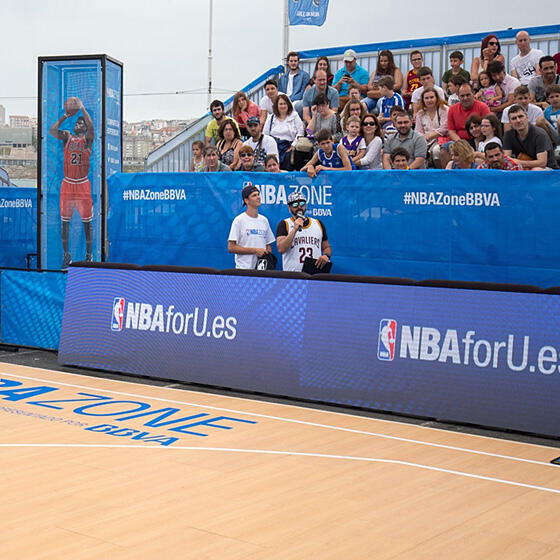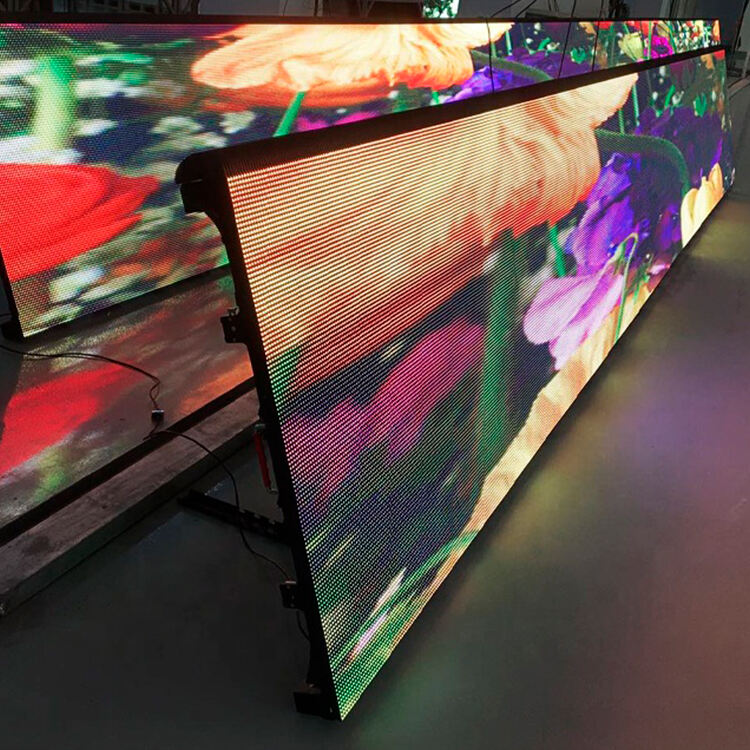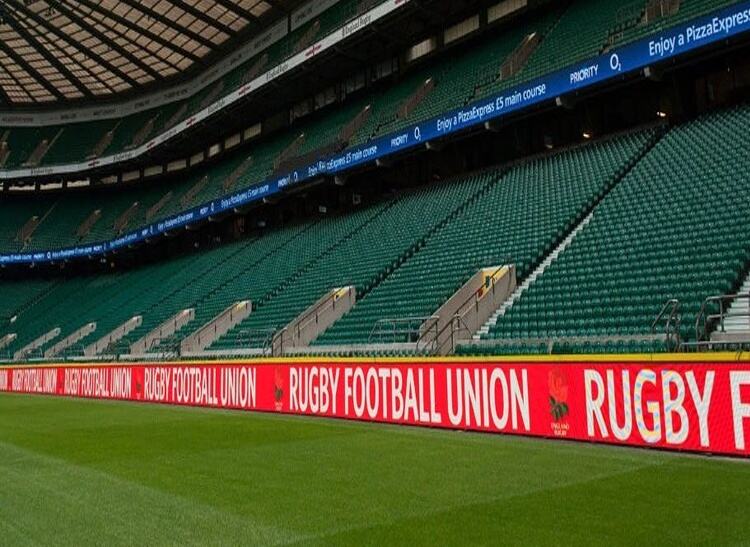一、 Definition of stadium display screen
Stadium LED display refers to a large-scale electronic display device that uses LED technology for stadiums. It has the characteristics of high brightness, high definition, bright colors, strong contrast, wide viewing angles, etc., and can clearly and accurately display game-related information, wonderful moment replay, advertising and interaction with the audience in different lighting environments.


二、the innovative technology of LED display in stadiums
Display technical aspects
1. High-definition and ultra-high-definition display: The resolution continues to increase, such as 4K and 8K levels, bringing clearer, more delicate and realistic images to the audience, whether it is the details of the game or the wonderful playback.
2. High refresh rate technology: Improve the smoothness of the picture, especially for fast-moving sports scenes, and reduce ghosting and blurring.
3. 3D display technology: Combined with special glasses and other equipment, it can achieve 3D game viewing effect, so that the audience has a stronger sense of immersion.
4. Transparent LED display technology: It can display information and dynamic images in some special locations such as the top edge of the venue and corridors without affecting the lighting of the venue and the sight of the audience.
5. Flexible LED display: It can be customized and installed according to the special structure of the stadium (such as curved wall, etc.), presenting a unique display layout.
Interactive technology
1. Somatosensory interaction: Through infrared, radar and other sensing technologies, the audience can interact with the display screen through body movements, such as simulating participation in sports on the display.
2. Mobile terminal interconnection and interaction: The audience can use mobile phones and other mobile devices to interact with the LED display of the venue, such as sending on-site photos, leaving messages on the big screen, participating in on-site voting, event guessing, etc.
3. Interactive display on the ground: For example, the ultra-thin LED floor mat screen can display different contents and effects according to people's pedaling and movement tracks, so as to enhance interest and interactivity.
Intelligent control technology
1. Intelligent brightness adjustment: Automatically adjust the brightness of the screen according to the ambient light (such as day, night, and lighting changes in the venue, etc.) to achieve a balance between energy saving and comfortable viewing.
2. Intelligent content switching: Automatically switch to display appropriate content (match screens, advertisements, replays, statistics, etc.) according to different stages of the event (in-game, pause, halftime, awards, etc.).
3. Intelligent fault monitoring and early warning: real-time monitoring of the operation status of the display screen, and timely notification of technical personnel for maintenance in case of hidden faults.
4. Intelligent splicing technology: realize seamless and special-shaped splicing of multiple display screens to meet the display needs of different spaces and shapes of the venue.
Energy-saving and environmental protection technology
1. Common cathode technology: reduce the power consumption of the display and reduce the heat generation.
2. Efficient heat dissipation technology: Extend the life of the display screen and reduce the use of heat dissipation equipment such as air conditioners.
3. Intelligent energy management system: Optimize the power consumption strategy of the display screen in combination with the overall energy management of the venue.
Energy-saving and environmental protection technology
1. Common cathode technology: reduce the power consumption of the display and reduce the heat generation.
2. Efficient heat dissipation technology: Extend the life of the display screen and reduce the use of heat dissipation equipment such as air conditioners.
3. Intelligent energy management system: Optimize the power consumption strategy of the display screen in combination with the overall energy management of the venue.
Content innovation presentation technology
1. AI-assisted content generation: For example, AI is used to generate game data visualization graphics, special effects packaging for wonderful moments, etc.
2. Virtual studio combination technology: Through green screen and other technologies combined with virtual scenes and live pictures, the fantasy event scene or background is displayed on the LED display.
3. Real-time data visualization and dynamic display: The athlete's physiological data (heart rate, etc.) and real-time game data (such as speed, strength, etc. obtained through sensors) are displayed on the screen in the form of dynamic charts.

- the advantages of LED display in stadiums
Display Effect:
1. High brightness and clarity, even clear in strong outdoor light, perfect presentation of game details and replay.
2. Large-size, wide-angle vision, the audience can see clearly from all angles.
3. High contrast, vivid colors, bring a strong visual impact.
4. Ultra-high resolution, display more delicate images and videos through stitching.
Features:
1. Real-time update and interaction, network control, some can interact with the audience, such as voting, leaving messages.
2. Accurate timing and scoring, multiple modes, automatic alarm, real-time display of race status.
3. Multimedia display, play wonderful moments, advertisements, etc., to enhance the viewing experience.
4. Customized and creative design, adapted to the venue, bringing unique visual effects.
Durability & Maintenance:
1. Durable, LED technology, long life, low energy consumption, environmental protection, adapt to various environments.
2. Easy maintenance, modular, faulty modules can be quickly replaced.
Commercial & Other Value:
1. High commercial value, broadcast advertisements to increase the income of the venue and promote for sponsors.
2. Enhance the atmosphere of the event, with the music screen, bring a visual feast.
3. Enhance the image and attractiveness of the venue to attract events and spectators.
4. Ensure the fairness of the game, and play it in slow motion to help the referee decide.

四、What are the precautions for the use of LED displays in stadiums?
1. Installation and commissioning
1). Ensure that the installation is firm: During the installation process, it is necessary to ensure that the installation structure of the display screen is stable and able to withstand the influence of various external forces and environmental factors, such as wind and vibration.
For example, in outdoor stadiums, if the installation is not firm in windy weather, the display may shake or even fall, causing a safety hazard.
2). Correct debugging: Carry out comprehensive debugging before use, including image display effect, color calibration, brightness uniformity, etc., to achieve the best display effect.
For example, in a soccer match, if the color deviation of the display is large, it may affect the viewer's viewing experience.
2. the operating environment
1). Temperature and humidity control: Temperature and humidity in stadiums can vary greatly, so ensure that the display is operating within the appropriate temperature (typically 0 40°C) and humidity (typically 10% 85% non-condensing).
For example, in the hot summer, the temperature in the stadium is too high, and if the display screen is not well dissipated, it may cause malfunction.
2). Dust and waterproof: According to the actual situation of the stadium, take appropriate dust and waterproof measures, especially in outdoor venues.
For example, when it rains, rain ingress may damage internal circuitry if the display is not adequately protected.
3. Operation and use
1). Follow the operating procedures: The operator should be familiar with the operation process and control software of the display screen to avoid misoperation.
For example, switching the display mode incorrectly may cause the screen to be confused.
2). Control the content displayed: Ensure that the content displayed complies with laws, regulations, and ethical norms, and does not disseminate bad information.
Assuming that illegal or inappropriate content is broadcast, it may cause controversy.
4. maintenance and maintenance
1). Regular cleaning: Clean the surface of the display regularly to remove dust and dirt to maintain a good display effect.
If left uncleaned for a long time, dust accumulation may affect brightness and clarity.
2). Check the line: Regularly check whether the line connection is loose and whether the power supply is stable.
Loose lines may cause signal interruptions or short circuits.
3). Spare parts reserve: prepare the necessary spare parts so that they can be replaced in time in case of failure.
If a critical component is damaged, spare parts are available to quickly restore normal operation.
5. Safety and security
1). Power safety: Ensure the power supply of the display screen is stable, install overload protection and leakage protection devices.
Sudden power fluctuations can cause irreversible damage to the display.
2). Personnel safety: In the process of installation and maintenance of the display screen, it is necessary to ensure the safety of staff and take necessary protective measures.
For example, you must wear a seat belt when climbing at height.
In conclusion, the proper use and maintenance of LED displays in stadiums can extend their service life and provide better services and experiences.

五、How long is the maintenance cycle of LED display in stadiums?
Routine Maintenance:
Daily: Check whether the display is operating normally, including whether the image display is clear, whether there is a blurred screen or a black screen, etc.
Weekly: Perform a simple cleaning of the display surface to remove visible dust and stains.
Scheduled Maintenance:
Monthly: Check if the wiring connection is loose and if the cooling system is working properly.
Quarterly: Conduct a more comprehensive cleaning, including dust removal from the interior. At the same time, calibrate and adjust the brightness and color of the display.
Semi-annually: check whether the power supply is stable, and check and maintain the control system.
Annual: Deep maintenance of the entire display, including replacement of aging parts, inspection and reinforcement of the steel structure (in the case of outdoor displays).
However, the specific maintenance interval needs to be adjusted based on the following factors:
1. Frequency of use: If the display is used frequently, the maintenance cycle should be shortened accordingly. For example, venues with frequent major sporting events may need to be inspected and maintained more frequently.
2. Environmental conditions: In harsh environments, such as high-temperature, high-humidity, and dusty stadiums, the maintenance cycle should be shortened. For example, in outdoor sports stadiums in coastal areas, deep cleaning and wiring inspections may need to be done every two months due to the salt and moisture brought in by the sea breeze.
3. Display quality: A better quality display may have a relatively long maintenance cycle, but regular maintenance should not be neglected.
4. Budget and manpower: Sufficient budget and manpower can support more frequent and meticulous maintenance.
In short, the maintenance cycle of LED display in stadiums needs to consider a variety of factors to ensure its stable operation and good display effect.
六、The case for LED displays in stadiums
Madison Square Garden, New York, United States: As a world-famous sports and entertainment venue, ultra-high-definition LED displays were installed not only for live matches and score displays, but also for spectacular visuals at shows and events.
Wembley Stadium, London: Equipped with a large circular LED display, it can provide the audience with clear game images, replays and related information display in all directions.
Beijing National Stadium (Bird's Nest): When hosting major sporting events and events, its state-of-the-art LED display provides an excellent viewing experience for spectators, whether it's close-ups of athletes or game data.
Melbourne Cricket Ground, Australia: The venue's LED display plays an important role in cricket matches, but is also used to host other sporting events and large events such as concerts.
These examples demonstrate the important role that LED displays can play in enhancing the viewing experience and enhancing the functionality of stadiums.
In general, from the European Cup to the Paris Olympics, to the standard venues of NBA events and other stadiums in China, the application of LED display in sports events has been very extensive and mature. They not only enhance the spectacle and commercial value of the competition, but also meet the needs of various events and spectators through continuous innovation and technological improvement. In the future, with the further development of technology, the application of LED display in sports events will be more in-depth and diversified.

 EN
EN
 AR
AR
 BG
BG
 HR
HR
 CS
CS
 DA
DA
 NL
NL
 FI
FI
 FR
FR
 DE
DE
 EL
EL
 HI
HI
 IT
IT
 JA
JA
 KO
KO
 NO
NO
 PL
PL
 PT
PT
 RO
RO
 RU
RU
 ES
ES
 SV
SV
 TL
TL
 IW
IW
 ID
ID
 SK
SK
 VI
VI
 HU
HU
 TH
TH
 TR
TR
 FA
FA
 AF
AF
 GA
GA
 BE
BE
 BN
BN
 LO
LO
 LA
LA
 MY
MY